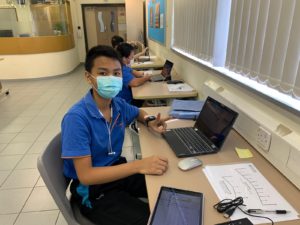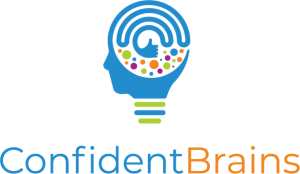
ARROWSMITH PROGRAM
COGNITIVE FUNCTIONS
STRENGTHEN CRITICAL COGNITIVE FUNCTIONS
Utilizing the Arrowsmith Program cognitive training exercises, Confident Brains helps people strengthen critical cognitive functions related to learning.
Ability to understand the relationships among two or more concepts
Children and adults with this dysfunction oftentimes have an inability to read an analog clock; to discern the difference between the hour and minute hands. They have trouble with cause and effect relationships like why events happen. Grammar and reading comprehension suffer because the relationships between elements or characters are not understood. For many with this dysfunction, there is a constant sense of uncertainty about whether the intended meaning (while reading or listening) has been correctly understood.
Ability to carry out internal sequential mental operations, such as mental math
Does counting on fingers sound familiar? Problems with math and counting processes could signal trouble with your child’s quantification sense. This dysfunction impairs a child or adult from doing mathematics inside his or her head, or carrying out internal sequential mental operations.
Ability to learn and produce written sequence of symbols
Writing out the alphabet, or a sequence of numbers, or expressing thought in speech are problems for children and adults with this dysfunction. Words may be misread, or handwriting may be messy and irregular. While focussing on writing, the content is often neglected, and sometimes the same word is spelt different ways on the same page.
Ability to understand the relationships among two or more concepts
Children and adults with this dysfunction oftentimes have an inability to read an analog clock; to discern the difference between the hour and minute hands. They have trouble with cause and effect relationships like why events happen. Grammar and reading comprehension suffer because the relationships between elements or characters are not understood. For many with this dysfunction, there is a constant sense of uncertainty about whether the intended meaning (while reading or listening) has been correctly understood.
Ability to develop and maintain plans and strategies through the use of language
Is your child easily distracted from a task and frequently labelled as having a short attention span? Children and adults with this dysfunction cannot maintain the focus of their attention in their studies, job or a social situation. They are often passive in learning situations, unable to plan how to start a task.
Ability to register and interpret non-verbal information and plan and problem solve non-verbally
Is your child’s behaviour sometimes inappropriate for the situation? Children and adults with this dysfunction often have trouble registering and interpreting their own emotions, or the facial expressions and body language of others. In class, a student may not be able to interpret a teacher’s reactions—therefore not knowing if the teacher approves of her work or not.
Ability to see how words and numbers interconnect sequentially into fluent sentences and procedures
Does your child try to be helpful, or do they often do something without asking beforehand? With this dysfunction, a child is not capable of considering the possible consequences of the action beforehand. For example, the child washes his father’s car that has just been waxed, or the child trims the tree in the front yard almost cutting it down.
Ability to learn to pronounce syllables and then integrate them into the stable and consistent pronunciation of a word
With this dysfunction, struggling with thinking and talking at the same time, requiring more concentration to pronounce words, or sometimes losing one’s train of thought are all typical problems. These difficulties result in shyness (quietness) in new situations involving talking with people, and a tendency to get drowned out by people who find it easier to speak.
Ability to visually recognise and remember a word or symbol
Does your child study a word many times before she can visually memorise it, recognise it, and then say it correctly the next time she sees it? Often children and adults with this dysfunction cannot recognise a word like “house” as the same word she has seen before. The result: learning to read and spell words is a very slow process.
Ability to remember several unrelated words in a series
Does your child have trouble learning the names of things? This dysfunction is associated with trouble remembering more than three words in a series, or that one word is a synonym for another.
This is the capacity for perception of where both sides of the body are in space. The following are features of a problem in this capacity.
- The person has limited awareness of where one or both sides of his body are in space. He has a tendency to bump into objects, doorways, etc. with the affected side of the body.
- When driving a car the person is less aware of one side of the car than the other. This can result in scratching the car more frequently on one side, taking corners too wide and driving too close to either the right or left side of the road.
- The person is less aware of where his hands and fingers are when cutting with a knife or using tools and as a result may injure himself more often than other people.
- If the problem is severe the person may hurt himself on the impaired side and be less aware of where the pain is coming from.
- If the problem occurs in the writing hand there is uneven pressure and the person wanders on and off the line when writing.
- In more severe cases there is an inability to recognize objects through a sense of touch. A person can not distinguish between his keys or lighter when feeling in his pocket.
- There may be some degree of awkwardness of body movement.
- There is also less articulated mouth movement which results in some speech slurring.
This is the capacity responsible for the number of symbols or objects a person can see in one visual fixation. When the span is restricted to below four symbols the following problems occur.
The person cannot see whole words in a single visual fixation. He must make three to ten times the normal number of fixations to read a line of printed material. This causes severe eye fatigue when reading and in severe cases can result in temporary blindness from overworking the eyes. People with this problem report that they cannot read for more than 30 to 60 minutes without taking a break to rest their eyes. The eyes become bloodshot as the eye muscles are overworked from making visual fixations.
Reading is experienced as jerky and errors occur when the eyes become fatigued and miss fixations. These types of errors also occur in clerical work.
Reading speed is slowed down due to the extra time required to make the increased number of visual fixations.
Navigating in the dark is difficult, e.g., finding a seat in a darkened movie theatre or driving in the dark.
This is the capacity for recognising and remembering the details of visual objects. A weakness in this capacity is indicated by the following characteristics.
A person with this problem takes longer to visually recognise and locate objects that he is looking for. There is difficulty finding items when shopping. The person walks by an item several times before he recognises it. The person also has trouble locating something in a refrigerator.
A manager of a drugstore with this problem had great difficulty learning to recognise his products and remember their locations in the store.
The person has trouble remembering visual cues such as landmarks to help in the process of remembering the location of places.
The person has trouble recognising and remembering faces and will miss details in facial expressions both of which cause social and interpersonal problems.
The person has trouble remembering the visual details of pictures.
What is Arrowsmith?
Learn more about the Arrowsmith Program and how we utilise it to help you build a stronger brain.
Our Programs
Learn more about our revolutionary brain training programs, now available online.
Contact Us
Questions? Contact us today and learn more about how we can improve your cognitive capacity.
BLOG


Our Brains at Work, Rest, and Play – Webinar Series Pt. 2

